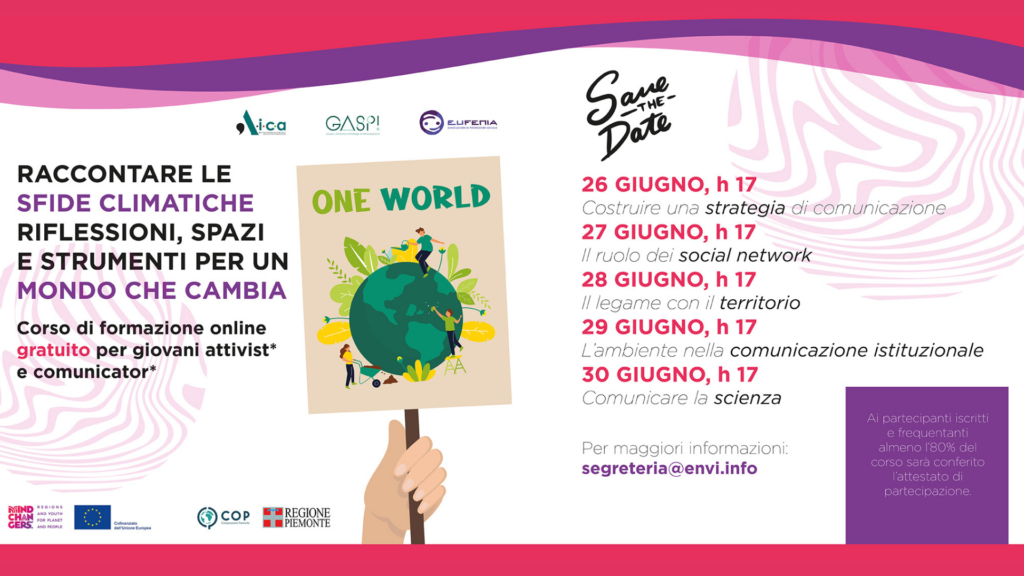A week of training to learn how to constructively communicate about the environment
Communication in its broader and primitive form is one of the oldest languages that humanity has ever used. In a more connected world that is the world of today, it is needless to pinpoint how tremendous the role of communication has become; however if we were to ask Socerate on the true meaning of communicating, he would instantly associate it with dialogue and critical thinking rather than spreading information.
During the 5-day training program from the 26th till the 30th of June 2023 organized by AICA, the meaning of communication has been discussed with a specific focus on environmental communication. Each day has been dedicated to the types of channels to tackle the challenges related to this topic, to the stakeholders involved, and to the good practices that organizations and people can undertake to add value to climate protection.

Communication can be understood as the action of transferring a message from one person to another or to a group. This involves responsibility on what message one wants to communicate, how and to whom. Social networks offer a variety of platforms to actively engage communities in the topic, whether through streaming sessions, posts, newsletters and online challenges to name a few. The social network that is chosen also plays a role in emphasizing the message: people are more attracted to images and short contents that give the key points in colorful and sometimes comic ways. Instagram and TikTok can be taken as reference but this does not put long format or written content in a second position. Both should be used depending on the type of information communicated, whether it is a scientific paper, a report or just a moral incentive to incorporate in daily routines. Following these affinities, it is important to distinguish the territorial communication from the institutional one.
As communicators participating in the green transition, the territory in which we evolve – and in which most of the audience would be – reshapes the way we bring an idea to the public. The territory in this case can be both on the global and local scale depending on the scope of the actions taken to change mindsets by promoting systemic thinking. If we differentiate between causality and correlation to intentionally highlight the real connections between the climate catastrophes in different places of the globe, we can raise a universal awareness that leads to unity hence, to more effective measures.
Along with the notion of space, institutions are the actors influencing the organization of territories and foster decision-makers. The first and most revolutionary initiative that has been taken to involve active participation of institutions and the public in environmental matters is the Aarhus convention signed on 25th June 1998 in the Danish city of Aarhus. This one-of-kind agreement linked climate issues to human rights, focused on the principle of responsibility and associated government accountability with environmental protection.
The main goal of institutional communication is to always keep citizens informed on the discoveries around climate change, the risks and orient general conversation towards finding solutions. Governments, businesses or universities can take part in this communication by planning events, campaigns, publishing reports on their carbon footprint or keeping track of different metrics whether environmental or social. It is not only about sharing information, but every statistics paints a clearer picture of what people are dealing with and helps interests to converge. Citizens’ assemblies have been successful in bringing people together to structure plans that are concretely applicable in their local regions.
Finally, scientific communication on the environment remains the common matrix for the previous types of communication. This involves research, a specific language to only communicate the key points of a message, the facts, the official figures, precise analyses and requires a certain distance from the psychological influence when dealing with harsh topics. Science is neither journalism nor literature but this does not necessarily imply that it should be inaccessible to people who are not experts in certain fields. The main goal of understanding the importance of science in environmental communication is to learn ways to recognize fake news and contribute to the spread of proven facts. There are lists of official references of scientific features such as the GIEC report or the official websites of international organizations and labs that provide true and transparent data. Avoiding conspiracies, trends, fuzzy words and random scientific posts are good practices to not fall in the trap of fallacies.
This was a small glimpse of the content of the training program which involved many distinguished guests who shared their knowledge and practical experience in addition to the involvement of the participants in valuable debates.
The next activities are planned in September 2023 so stay tuned, follow AICA and Envi.info on social media and be curious, be enthusiastic and be brave to defend the values that will save our planet, save our generation and those to come.
Many thanks to our guests: Debora Paolini, Ludovica Nati, Rolando Cervi, Giulia Marrazzo and Franco Borgogno.

